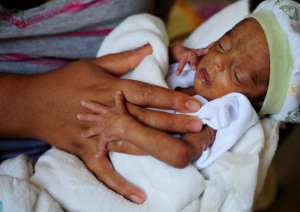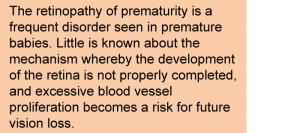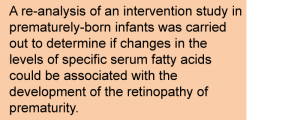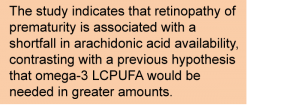New Insight into the Retinopathy of Prematurity
This article at a glance
- A recent intervention study that evaluated the usefulness of supplementing the parenteral feed of premature babies with long-chain omega-3 fatty acids to alleviate the retinopathy frequently associated with premature birth was unsuccesful.
- An assessment of the fatty acid levels in the prematurely-born babies now indicates that low levels of arachidonic acid are strongly associated with the development of retinopathy of prematurity.
- The results suggest that future studies should specifically address if premature babies also have a defined minimal requirement for arachidonic acid in the last trimester of pregnancy to complete the proper vascularization of the developing retina.
.

Babies born before the 37th week of gestation are considered premature and face a higher risk of several complications compared to term babies. These complications are the consequence of the disruption of in utero development. The retinopathy of prematurity is one of such complications that develops during the first weeks after premature birth. In this disorder, the normal development of the retina during the third trimester of pregnancy is disrupted, and instead an abnormal vascular hyper-proliferation in the retina takes place during the first weeks after birth. This vasculo-proliferative development is also accompanied by loss of vascular integrity, the formation of tears and folds in the retina, and in severe cases the detachment of the retina. The retinopathy of prematurity has long-lasting consequences for vision at later ages, such myopia, amblyopia (lazy eyes) and strabismus, and even blindness, in case of scarring or detachment of the retina. Distinct grades of retinopathy severity have been defined, corresponding to the level of vascular proliferation and structural damage to the retina.
The incidence and severity of the retinopathy of prematurity increase with lower gestational age at birth, with an incidence of >80% in premature babies weighing less than 1000 grams. Exposure to elevated oxygen concentrations is an additional factor contributing to the retinopathy of prematurity, and although carefully controlled in specialist premature nurseries, its use may be necessary to oxygenate premature babies weighing less than ~1500 grams. To avert later life vision loss, children born prematurely should receive regular eye examinations. The disorder can be treated with some success using procedures such as cryopexy (cryotherapy surgery) or laser treatment to limit the excessive blood capillary proliferation. However, there are limitations to what can currently be done to prevent the disorder from occurring in the first place, and research to understand its precise causes and the development of efficacious approaches for early treatment in premature newborns is much needed. Much effort is currently focused on understanding the dysregulated vascular development of the retina, and animal models for the disorder have been developed. Since aberrant angiogenesis is a central aspect of the retinopathy of prematurity, and because angiogenesis is potently regulated by derivatives of polyunsaturated fatty acids, scientific interest has focused on the importance of adequacy in omega-3 LCPUFA, and the modulation of vascular growth factor levels in the eye, in preventing or addressing the angiogenic response in premature infants.

The potential utility of fish oil-containing parenteral emulsions in premature infants (gestational age <28 weeks) was recently addressed in a randomized open-label controlled intervention trial, the DonnaMega study. The circulating levels of EPA in the infants increased (and those of DHA slightly), and the ratio of arachidonic acid to DHA decreased from birth to 32 weeks postmenstrual age. The neonates had received the fish oil-containing parenteral feed at 2-3 gram/kg body weight every 24 hours. They also received enteral feeding according to clinical routine for each preterm, consisting of maternal or donor breast milk. However, compared to a parenteral feed based on olive oil, the fish oil-rich parenteral feeding did not affect the incidence of retinopathy of prematurity or affect growth. It also did not modify the incidence of other complications that occur frequently in premature newborns such as bronchopulmonary dysplasia, necrotizing enterocolitis, patent ductus arteriosus and sepsis. The results of the DonnaMega Study suggested that omega-3 LCPUFA may not be necessary to avoid retinopathy of prematurity, even though these infants had missed out on a large portion of the EPA and DHA that are normally actively accreted by the fetus during the last trimester.

The observation led to the question if possibly other endogenous factors or specific nutrients could be necessary to ameliorate specific aspects of the morbidity associated with premature birth. Reanalysis of the results from the DonnaMega study was undertaken to determine if other fatty acids might display any relationship with the risk of developing retinopathy of prematurity in this well-characterized sample of preterm neonates. The results were recently reported by Löfqvist and colleagues from the Section of Ophthalmology at the Department of Clinical Neuroscience, Institute of Neuroscience and Physiology, Sahlgrenska Academy, and the departments of Paediatrics, and Biology and Environmental Sciences, University of Gothenburg, Göteborg, Sweden, and the Department of Ophthalmology at Boston Children's Hospital, Harvard Medical School, Boston, MA, U.S.A.. The researchers examined serum fatty acid levels (expressed as fraction of the total fatty acids in phospholipids) of the premature newborns at birth, and at 1 day, at 1, 2 and 4 weeks after birth, and again at 32, 36 and 40 weeks postmenstrual age. A comparison was made between babies that developed retinopathy (distinguishing any level of disease from severe retinopathy) and those that did not.
The 78 premature infants that survived (57% girls) had an average gestational age at birth of 25.5 ± 1.4 weeks, and an average birthweight of 797 grams. Other complications of prematurity were bronchopulmonary dysplasia, necrotizing enterocolitis, patent ductus arteriosus and sepsis observed in 39%, 5%, 54% and 30%, respectively, of the infants. Only 17 babies did not develop retinopathy. Because the neonates with severe retinopathy had a lower gestational age and birthweight than infants that did not develop retinopathy, two periods of development were analyzed: the first month after birth, during which longitudinal changes were analyzed, and at post-menstrual ages 32, 36 and 40 weeks, where differences were compared for each timepoint. This allowed for making better corrections of the duration of parenteral nutrition received, and for gestational age and weight at birth.
The analysis of longitudinal phospholipid LCPUFA profiles showed that only a significantly lower concentration of arachidonic acid was observed over the course of the first month after birth in infants with retinopathy of prematurity. No other fatty acids displayed differences between babies without or with any level of retinopathy. A similar observation was made at the 32 weeks post-menstrual age; neonates with retinopathy had lower levels of AA than babies without the complication. Dihomo-gamma-linolenic acid level, a precursor of arachidonic acid formation, was also lower at this time point. The absolute differences measured in serum were small (in the order of 1% difference in the fractional percentage).
A Receiver Operating Characteristic (ROC) curve analysis was employed to determine the relationship between the true positive rate (termed sensitivity) of the probability that neonates developed a severe or any level of retinopathy and the false positive rate (calculated as 1 minus the specificity, which is the true negative rate, i.e. the proportion of neonates correctly diagnosed not developing retinopathy) over the first month after birth. This relationship was calculated after adjustment for precise gestational age, the serum AA level, or the interaction of both. Calculation of the area under the curve (termed accuracy) showed a good predictive relation that retinopathy develops in premature babies born at low gestational age and who have a low serum arachidonic acid (AA) level. There was good discriminating power for neonates during the first month after birth and at 32 weeks postmenstrual age. Having only a low AA level, or just being born at a lower gestational age, failed to predict the development of retinopathy of prematurity.

The result of this secondary analysis strongly suggests that, contrary to the initial hypothesis that a deficit in omega-3 LCPUFA availability was responsible for the development of the retinopathy of prematurity, it is a reduced availability of AA in the last trimester that may underlie the disorder. This new awareness provides an important indication to re-value the importance of specific polyunsaturated fatty acids other than omega-3 LCPUFA for specific phases of organ development in the fetus, as well as for supporting the healthy development of preterm babies. Whereas the provision of omega-3 LCPUFA is known to be very important for fetal development, particularly during the last trimester in the development of the central nervous system, recent studies have started to suggest the importance of AA in the development of the lungs and airways, in which a deficit may underly the development of bronchopulmonary dysplasia as a consequence of preterm birth. New studies that aim to address complications of prematurity will have to make a more sophisticated assessment of the requirements of specific fatty acids that are essential for the development of specific organs and tissues.
Löfqvist CA, Najm S, Hellgren G, Engström E, Sävman K, Nilsson AK, Andersson MX, Hård AL, Smith LEH, Hellström A. Association of retinopathy of prematurity with low levels of arachidonic acid: A secondary analysis of a randomized clinical trial. JAMA Ophthalmol. 2018;136(3):271-277. [PubMed]
Worth Noting
Hartnett ME. Advances in understanding and management of retinopathy of prematurity. Surv. Ophthalmol. 2017 62(3):257-276. [PubMed]
Mantagos IS, Vanderveen DK, Smith LE. Emerging treatments for retinopathy of prematurity. Semin. Ophthalmol. 2009;24(2):82-86. [PubMed]
Najm S, Löfqvist C, Hellgren G, Engstrom E, Lundgren P, Hard AL, Lapillonne A, Savman K, Nilsson AK, Andersson MX, Smith LEH, Hellström A. Effects of a lipid emulsion containing fish oil on polyunsaturated fatty acid profiles, growth and morbidities in extremely premature infants: A randomized controlled trial. Clin. Nutr. ESPEN 2017;20:17-23. [PubMed]
Receiver Operating Characteristic curve analysis: http://gim.unmc.edu/dxtests/roc3.htm
Retinopathy of prematurity: http://nethealthbook.com/eye-diseases-and-eye-related-topics/retinal-problems/retinopathy-prematurity/

